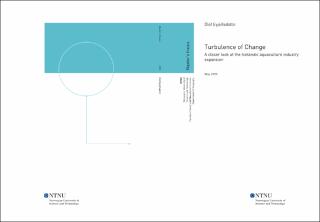| dc.contributor.advisor | Steen, Markus | |
| dc.contributor.author | Eyjólfsdóttir, Ólöf | |
| dc.date.accessioned | 2021-09-28T17:53:49Z | |
| dc.date.available | 2021-09-28T17:53:49Z | |
| dc.date.issued | 2020 | |
| dc.identifier | no.ntnu:inspera:56114793:16068397 | |
| dc.identifier.uri | https://hdl.handle.net/11250/2785178 | |
| dc.description.abstract | Den islandske havbruksnæringen har vært i en utvidelsesperiode, særlig innen lakseoppdrett til sjøs. Dette er delvis skyldes investering og kunnskapsoverføring fra Norge. Denne forskningen ser på industrien når det gjelder denne utvidelsen, og spør hvordan den islandske laksenæringen oppfattes, hvordan den oppfatter seg selv og hvor den står når det gjelder bærekraft? Hvilke hindringer og utfordringer den står overfor og hvorfor, hvilke muligheter de gir og hva har industriens respons vært? For å svare på disse spørsmålene ble det gjennomført intervjuer med enkeltpersoner direkte og indirekte koblet til bransjen. I tillegg ble sekundære data brukt for å supplere intervjudata og utforske relevante problemer. Teori som ble brukt til å analysere bransjens bærekrafts status var Two Tier Sustainability Equilibrium, men for å forstå det komplekse forholdet mellom ulike aktører, institusjoner og miljøfaktorer og hvordan de hindrer eller muliggjør utvikling/endring i industrien, ble Multi-Level Perspektivet brukt. Denne forskningen fant at industrien (forventede) bidrar/konfronteres med miljøproblemer, selv om det i mindre grad enn f.eks. Norge og jobber mot bærekraftig praksis. Videre har industrien hatt en positiv effekt på tilstøtende samfunn og blir gradvis økonomisk sterkere til tross for hindringer, noe som antyder at industrien er fokusert på bærekraftig utvikling. Næringen oppfattes imidlertid ganske negativt av forskjellige aktørgrupper, særlig de som har høy innsats når det gjelder rømming av laks. Dette har resultert i en av bransjens viktigste hindringer: mangel på legitimitet, som har fungert som et press på industrien til å gjøre det bedre og fokusere på bærekraft. Videre ble viktige overvåkningsinstitusjoner identifisert som en andre hindring, da de ikke var forberedt på utvidelsen. Videre ble tre viktige utfordringer identifisert: romlig differensiering ettersom industrien trenger å tilpasse praksis til det islandske miljøet; sted, som Island er i en ulempe med å gjøre avstand til globale markeder; og miljøfaktorer som etter hvert kan påvirke produktets kvalitet. Tatt i betraktning det maritime innovasjonsmiljøet, kan disse utfordringene vekke en livlig nisjeutvikling, da industrien prøver å løse disse problemene. | |
| dc.description.abstract | The Icelandic aquaculture industry has been going through a period of expansion, particularly in salmon farming at sea. This is in part thanks to investment and knowledge transfer from Norway. This research looks at the industry in terms of this expansion, asking how the Icelandic salmon industry is perceived, how it perceives itself and where it stands in terms of sustainability? Which obstacles and challenges it is facing and why, which opportunities do these present and what has the industry’s response been? To answer these questions, interviews with individuals directly and indirectly connected to the industry were conducted. Furthermore, secondary data was used to supplement interview data and explore relevant issues. Theory used to analyse the industry’s sustainability status was the Two Tier Sustainability Equilibrium, but to understand the complex relationship between various actors, institutions, and environmental factors and how they obstruct or enable development/change in the industry, the Multi-Level Perspective was used. This research found that the industry is (expectedly) contributing/confronted with environmental problems, although to a lesser extent than e.g. Norway and is working towards sustainable practices. Furthermore, the industry has had positive effect on adjacent societies and is gradually getting economically stronger in spite of hindrances, suggesting industry is focused on sustainable development. However, the industry is perceived rather negatively by various actor groups, particularly those that have high stakes in the case of salmon escapes. This has resulted in one of the industry’s key obstacles: lack of legitimacy, which has acted as a pressure on the industry to do better and focus on sustainability. Furthermore, key monitoring institutions were identified as a second obstacle, as they were unprepared for the expansion. Furthermore, three key challenges were identified: spatial differentiation as the industry needs to adapt practices to the Icelandic environment; place, as Iceland is at a disadvantage do to distance to global markets; and environmental factors which could eventually impact the product’s quality. Considering the maritime innovation environment, these challenges could spark vibrant niche development, as the industry attempts to solve these problems. | |
| dc.language | | |
| dc.publisher | NTNU | |
| dc.title | Turbulence of Change: A closer look at the Icelandic aquaculture industry expansion | |
| dc.type | Master thesis | |
